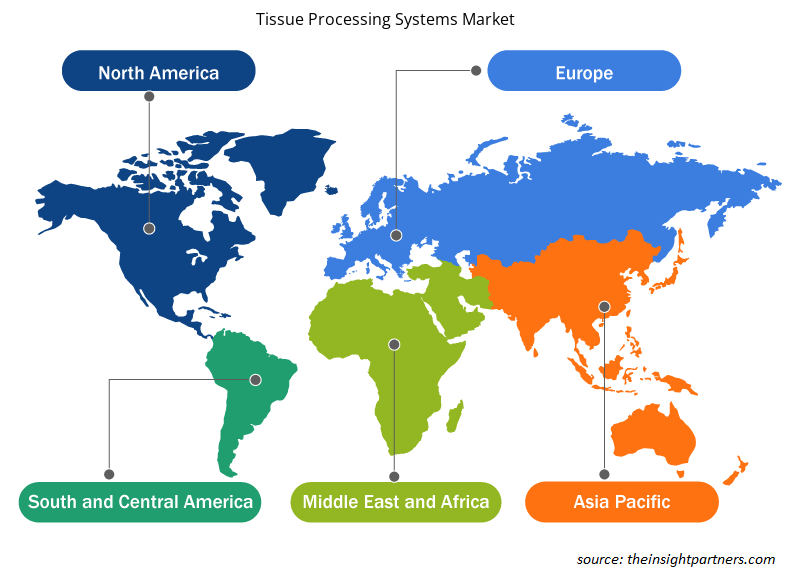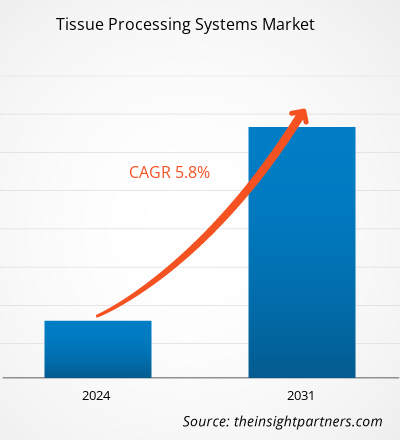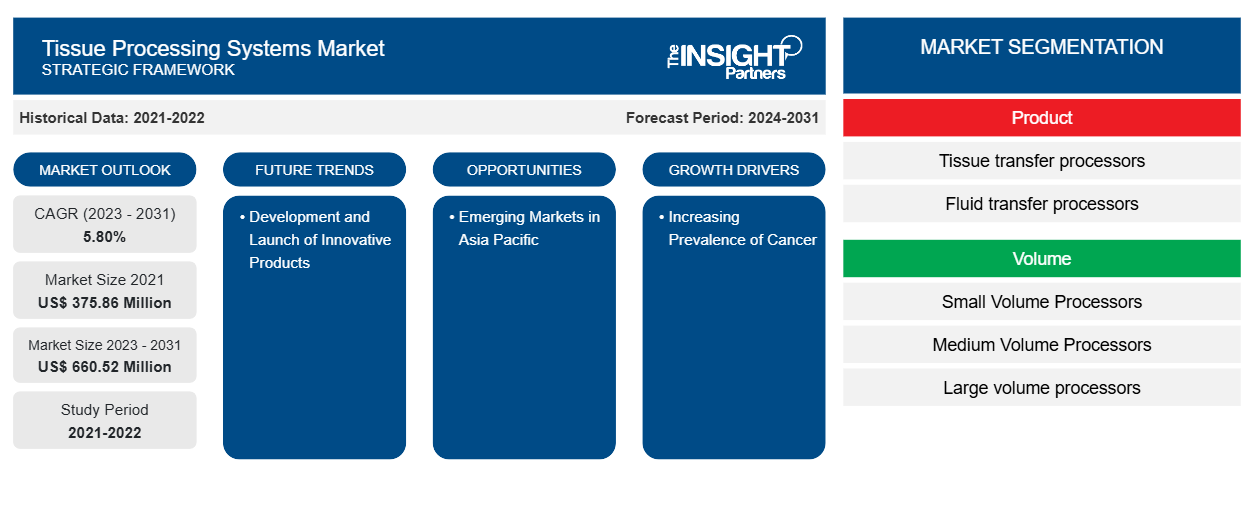Der Markt für Gewebeverarbeitungssysteme wurde im Jahr 2021 auf 375,86 Mio. USD und im Jahr 2023 auf xx Mio. USD geschätzt. Es wird erwartet, dass er bis 2031 660,52 Mio. USD erreicht und bis 2031 eine durchschnittliche jährliche Wachstumsrate von 5,80 % verzeichnet. Veränderte Verbraucherpräferenzen und technologische Fortschritte werden voraussichtlich weiterhin die wichtigsten Trends auf dem Markt für Gewebeverarbeitungssysteme bleiben.
Marktanalyse für Gewebeverarbeitungssysteme
Die zunehmende Verbreitung von Krebs wird voraussichtlich das Wachstum des Marktes für Gewebeverarbeitungssysteme vorantreiben. Die zunehmende Verbreitung des Krebses wird voraussichtlich die Nachfrage nach Gewebeverarbeitungssystemen für die Diagnose erhöhen. Laut der Krebsagentur der Weltgesundheitsorganisation (WHO), der Internationalen Agentur für Krebsforschung (IARC), gab es im Jahr 2022 schätzungsweise 20 Millionen neue Krebsfälle und etwa 9,7 Millionen Todesfälle.
Marktübersicht für Gewebeverarbeitungssysteme
Der globale Markt für Gewebeverarbeitungssysteme ist nach Regionen unterteilt in Nordamerika, Europa, Asien-Pazifik, Naher Osten und Afrika sowie Süd- und Mittelamerika. Das Marktwachstum in dieser Region wird aufgrund von Faktoren wie der zunehmenden Krebsprävalenz und der steigenden Anzahl von Diagnoselabors erwartet . Die hohen Kosten der Krebsdiagnostik werden das Marktwachstum in den Prognosejahren jedoch voraussichtlich bis zu einem gewissen Grad behindern.
Passen Sie diesen Bericht Ihren Anforderungen an
Sie erhalten kostenlos individuelle Anpassungen an jedem Bericht, einschließlich Teilen dieses Berichts oder einer Analyse auf Länderebene, eines Excel-Datenpakets sowie tolle Angebote und Rabatte für Start-ups und Universitäten.
- Holen Sie sich die wichtigsten Markttrends aus diesem Bericht.Dieses KOSTENLOSE Beispiel umfasst eine Datenanalyse von Markttrends bis hin zu Schätzungen und Prognosen.
Markttreiber und Chancen für Gewebeverarbeitungssysteme
Steigende Zahl von Diagnoselabors begünstigt den Markt.
Aufgrund der Zunahme chronischer Krankheiten steigt die Zahl der Diagnoselabore. Die Zunahme chronischer Krankheiten wie Krebs, Diabetes und Herzkrankheiten führt zu einer erhöhten Nachfrage nach Diagnosediensten. Die Centers for Medicare & Medicaid Services regulieren alle Labortests, die in den USA an Menschen durchgeführt werden, durch die Clinical Laboratory Improvement Amendments (CLIA). Im März 2024 waren bei CLIA etwa 317.545 Labore registriert (ausgenommen/nicht ausgenommen). Darüber hinaus dürfte die Präsenz großer Diagnoselabore in den USA das Marktwachstum fördern. Quest Diagnostics ist beispielsweise ein führendes Unternehmen in der medizinischen Diagnosebranche und bietet Diagnosedienste in den USA an. Es ist das umfangreichste Netzwerk in den USA mit über 7.400 Patientenzugangspunkten, darunter Phlebotomisten in Arztpraxen und über 2.250 Patientenservicezentren.
Schwellenmärkte im asiatisch-pazifischen Raum – eine Chance auf dem Markt für Gewebeverarbeitungssysteme
Die Schwellenmärkte in den Entwicklungsländern im asiatisch-pazifischen Raum bieten bedeutenden Marktteilnehmern bessere Möglichkeiten, ihr Geschäft auszuweiten. Dies ist ein Hauptgrund für das Marktwachstum im Prognosezeitraum. Die meisten großen Akteure konzentrieren sich auf Schwellenmärkte wie Indien und China, da dort viele Krebspatienten leben und der Medizintourismus in den Entwicklungsländern zunimmt. Viele der Schwellenländer sind ein bevorzugtes Ziel für den Medizintourismus.
Laut dem Factsheet „Globocan 2022: India“ gab es im Jahr 2022 1.413.316 neue Krebsfälle und 916.827 Krebstodesfälle. Darüber hinaus werden der zunehmende Medizintourismus in Schwellenländern und die zunehmende Verbreitung chronischer Erkrankungen in der Region den auf dem Markt tätigen Akteuren im Prognosezeitraum voraussichtlich erhebliche Wachstumschancen bieten.
Segmentierungsanalyse des Marktberichts zu Gewebeverarbeitungssystemen
Wichtige Segmente, die zur Ableitung der Marktanalyse für Gewebeverarbeitungssysteme beigetragen haben, sind Dienstleistungen und Anwendungen.
- Basierend auf dem Produkt ist der Markt für Gewebeverarbeitungssysteme in Gewebetransferprozessoren und Flüssigkeitstransferprozessoren segmentiert. Das Segment der Flüssigkeitstransferprozessoren hielt den größten Marktanteil, während das Segment der Gewebetransferprozessoren im Prognosezeitraum voraussichtlich die höchste durchschnittliche jährliche Wachstumsrate (CAGR) auf dem Markt verzeichnen wird.
- Der Markt ist nach Volumen in Kleinvolumenprozessoren, Mittelvolumenprozessoren und Großvolumenprozessoren segmentiert. Das Kleinvolumensegment hielt im Jahr 2023 den größten Marktanteil. Es wird jedoch erwartet, dass das Mittelvolumensegment im Prognosezeitraum die höchste durchschnittliche jährliche Wachstumsrate (CAGR) auf dem Markt verzeichnet.
- Nach Endverbraucher wurde der Markt für Gewebeverarbeitungssysteme in Krankenhäuser, Pharmaunternehmen, Forschungslabore und andere segmentiert. Das Krankenhaussegment hielt den größten Marktanteil, während das Segment der Pharmaunternehmen im Prognosezeitraum voraussichtlich die höchste durchschnittliche jährliche Wachstumsrate (CAGR) auf dem Markt verzeichnen wird.
Marktanteilsanalyse für Gewebeverarbeitungssysteme nach Geografie
Der geografische Umfang des Marktberichts zu Gewebeverarbeitungssystemen ist hauptsächlich in fünf Regionen unterteilt: Nordamerika, Asien-Pazifik, Europa, Naher Osten und Afrika sowie Südamerika/Süd- und Mittelamerika.
Nordamerika umfasst die USA, Kanada und Mexiko. Der nordamerikanische Markt hatte im Jahr 2023 einen erheblichen Anteil am Weltmarkt. Die Nachfrage nach dem Markt in der Region wird im Prognosezeitraum voraussichtlich aufgrund verschiedener Faktoren wie der steigenden Krebsprävalenz, des zunehmenden Bewusstseins für den chronischen Gesundheitszustand sowie der Präsenz unterstützender Verbände in der Region stark wachsen. Es gab viele Organisationen, die an den Investitionen beteiligt waren und ein Bewusstsein für Krebs und seine Diagnostik schufen.
Der asiatisch-pazifische Raum ist aufgrund der zunehmenden Alterung der Bevölkerung, der steigenden Zahl von Krebserkrankungen, des technologischen Fortschritts und der zunehmenden staatlichen Initiativen zur Bereitstellung einer erschwinglichen, fortschrittlichen Gesundheitsversorgung sowie der steigenden Zahl von Start-ups und Medizintechnikunternehmen in dieser Region der am schnellsten wachsende Markt für Gewebeverarbeitungssysteme auf globaler Ebene. Darüber hinaus tragen die steigende Inzidenz und Mortalität von Krebs, Forschungsaktivitäten in der Region sowie die Präsenz von Verbänden oder Organisationen, die die Qualität der Krebsbehandlung verbessern, ebenfalls zum Marktwachstum bei.
Regionale Einblicke in den Markt für Gewebeverarbeitungssysteme
Die regionalen Trends und Faktoren, die den Markt für Gewebeverarbeitungssysteme im Prognosezeitraum beeinflussen, wurden von den Analysten von Insight Partners ausführlich erläutert. In diesem Abschnitt werden auch die Marktsegmente und die Geografie von Gewebeverarbeitungssystemen in Nordamerika, Europa, im asiatisch-pazifischen Raum, im Nahen Osten und Afrika sowie in Süd- und Mittelamerika erörtert.

- Erhalten Sie regionale Daten zum Markt für Gewebeverarbeitungssysteme
Umfang des Marktberichts zu Gewebeverarbeitungssystemen
| Berichtsattribut | Details |
|---|---|
| Marktgröße im Jahr 2021 | 375,86 Millionen US-Dollar |
| Marktgröße bis 2031 | 660,52 Millionen US-Dollar |
| Globale CAGR (2023 - 2031) | 5,80 % |
| Historische Daten | 2021-2022 |
| Prognosezeitraum | 2024–2031 |
| Abgedeckte Segmente | Nach Produkt
|
| Abgedeckte Regionen und Länder | Nordamerika
|
| Marktführer und wichtige Unternehmensprofile |
|
Dichte der Marktteilnehmer für Gewebeverarbeitungssysteme: Die Auswirkungen auf die Geschäftsdynamik verstehen
Der Markt für Gewebeverarbeitungssysteme wächst rasant, angetrieben durch die steigende Nachfrage der Endnutzer aufgrund von Faktoren wie sich entwickelnden Verbraucherpräferenzen, technologischen Fortschritten und einem größeren Bewusstsein für die Vorteile des Produkts. Mit steigender Nachfrage erweitern Unternehmen ihr Angebot, entwickeln Innovationen, um die Bedürfnisse der Verbraucher zu erfüllen, und nutzen neue Trends, was das Marktwachstum weiter ankurbelt.
Die Marktteilnehmerdichte bezieht sich auf die Verteilung der Firmen oder Unternehmen, die in einem bestimmten Markt oder einer bestimmten Branche tätig sind. Sie gibt an, wie viele Wettbewerber (Marktteilnehmer) in einem bestimmten Marktraum im Verhältnis zu seiner Größe oder seinem gesamten Marktwert präsent sind.
Die wichtigsten auf dem Markt für Gewebeverarbeitungssysteme tätigen Unternehmen sind:
- Agilent Technologies Inc.,
- Biogenex Laboratories,
- Sakura Finetek USA Inc.,
- Thermo Fisher Scientific Inc.,
- F. Hoffmann-La Roche AG,
- Siemens Ag,
Haftungsausschluss : Die oben aufgeführten Unternehmen sind nicht in einer bestimmten Reihenfolge aufgeführt.

- Überblick über die wichtigsten Akteure auf dem Markt für Gewebeverarbeitungssysteme
Marktnachrichten und aktuelle Entwicklungen zu Gewebeverarbeitungssystemen
Der Markt für Gewebeverarbeitungssysteme wird durch die Erhebung qualitativer und quantitativer Daten nach Primär- und Sekundärforschung bewertet, die wichtige Unternehmensveröffentlichungen, Verbandsdaten und Datenbanken umfasst. Im Folgenden finden Sie eine Liste der Entwicklungen auf dem Markt für Gewebeverarbeitungssysteme und -strategien:
- Im August 2023 brachte Sakura Finetek USA zwei neue Produkte der Marke Tissue-Tek Genie auf den Markt, die CISH-Tests auf dem Tissue-Tek Genie Advanced Staining System ermöglichen. (Quelle: Pressemitteilung des Unternehmens)
- Im Februar 2023 übernahm Clarapath, ein Robotikunternehmen, Crosscope. Die Übernahme kombiniert Clarapaths SectionStar, das erste vollautomatische All-in-One-System zum Schneiden und Übertragen von Gewebe, mit Crosscopes Workflow und computergestützten Pathologie-Tools, sodass Labore schneller, kostengünstiger und qualitativ hochwertigere Behandlungen durchführen können. (Quelle: Pressemitteilung des Unternehmens)
Marktbericht zu Gewebeverarbeitungssystemen – Umfang und Ergebnisse
Der Bericht „Marktgröße und Prognose für Gewebeverarbeitungssysteme (2021–2031)“ bietet eine detaillierte Analyse des Marktes, die die folgenden Bereiche abdeckt:
- Marktgröße und Prognose auf globaler, regionaler und Länderebene für alle wichtigen Marktsegmente, die im Rahmen des Projekts abgedeckt sind
- Marktdynamik wie Treiber, Beschränkungen und wichtige Chancen
- Wichtige Zukunftstrends
- Detaillierte PEST/Porters Five Forces- und SWOT-Analyse
- Globale und regionale Marktanalyse mit wichtigen Markttrends, wichtigen Akteuren, Vorschriften und aktuellen Marktentwicklungen
- Branchenlandschaft und Wettbewerbsanalyse, einschließlich Marktkonzentration, Heatmap-Analyse, prominenten Akteuren und aktuellen Entwicklungen
- Detaillierte Firmenprofile
- Historische Analyse (2 Jahre), Basisjahr, Prognose (7 Jahre) mit CAGR
- PEST- und SWOT-Analyse
- Marktgröße Wert/Volumen – Global, Regional, Land
- Branchen- und Wettbewerbslandschaft
- Excel-Datensatz
Aktuelle Berichte
Erfahrungsberichte
Grund zum Kauf
- Fundierte Entscheidungsfindung
- Marktdynamik verstehen
- Wettbewerbsanalyse
- Kundeneinblicke
- Marktprognosen
- Risikominimierung
- Strategische Planung
- Investitionsbegründung
- Identifizierung neuer Märkte
- Verbesserung von Marketingstrategien
- Steigerung der Betriebseffizienz
- Anpassung an regulatorische Trends





















 Kostenlose Probe anfordern für - Markt für Gewebeverarbeitungssysteme
Kostenlose Probe anfordern für - Markt für Gewebeverarbeitungssysteme